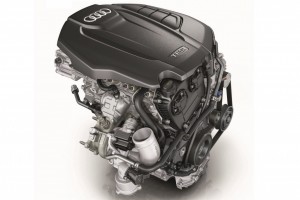Audi's 1.8-litre TFSI petrol engine revised
10 Aug 2011|6,524 views
 The new 1.8-litre TFSI engine has a displacement of 1,798cc, and produces 170bhp and 320Nm of torque. The unit is available for the recently facelifted A5 range, and when paired with the A5 Coupe manual, it allows the car to go from 0-100km/h in 7.9 seconds, and reach a top speed of 230km/h.
The new 1.8-litre TFSI engine has a displacement of 1,798cc, and produces 170bhp and 320Nm of torque. The unit is available for the recently facelifted A5 range, and when paired with the A5 Coupe manual, it allows the car to go from 0-100km/h in 7.9 seconds, and reach a top speed of 230km/h.Audi also says that the new engine is more fuel efficient, with average fuel consumption reduced by 21% to 5.7 litres per 100km. The unit also meets the latest Euro 6 emissions standards, which will be enforced starting from 2015.
The new engine features direct fuel injection (FSI) but with rail pressure increased from 150 to 200 bar. At the same time, it also uses indirect injection where fuel is sprayed at the end of the intake manifold when the engine operates at part-load. The direct injection system operates at start up and at higher engine loads. In addition, the variable valve system operates on the exhaust side and adjusts the camshafts in 2 angles, 30 or 60 degrees.
The new 1.8-litre TFSI engine is also lighter by 3.5kg over the previous unit, and features an all-new turbocharger with a maximum boost pressure of 1.3 bar. The turbine wheel is manufactured by a new alloy that can withstands temperatures up to 980 degrees Celsius and the electronic boost pressure controller adjusts pressure immediately in order to reduce fuel consumption.
It also has a fully electronically regulated cooling system that aims to bring the oil to operating temperature as fast as possible. This is done by operating the main radiator only at the last possible moment and by keeping the coolant in the crankcase for a long time. The exhaust manifold is integrated into the water-cooled cylinder head, reducing exhaust gas temperature and thus doing away with the need to use a rich fuel mixture at full engine load, further reducing consumption.
The new 1.8-litre TFSI engine has a displacement of 1,798cc, and produces 170bhp and 320Nm of torque. The unit is available for the recently facelifted A5 range, and when paired with the A5 Coupe manual, it allows the car to go from 0-100km/h in 7.9 seconds, and reach a top speed of 230km/h.
Audi also says that the new engine is more fuel efficient, with average fuel consumption reduced by 21% to 5.7 litres per 100km. The unit also meets the latest Euro 6 emissions standards, which will be enforced starting from 2015.
The new engine features direct fuel injection (FSI) but with rail pressure increased from 150 to 200 bar. At the same time, it also uses indirect injection where fuel is sprayed at the end of the intake manifold when the engine operates at part-load. The direct injection system operates at start up and at higher engine loads. In addition, the variable valve system operates on the exhaust side and adjusts the camshafts in 2 angles, 30 or 60 degrees.
The new 1.8-litre TFSI engine is also lighter by 3.5kg over the previous unit, and features an all-new turbocharger with a maximum boost pressure of 1.3 bar. The turbine wheel is manufactured by a new alloy that can withstands temperatures up to 980 degrees Celsius and the electronic boost pressure controller adjusts pressure immediately in order to reduce fuel consumption.
It also has a fully electronically regulated cooling system that aims to bring the oil to operating temperature as fast as possible. This is done by operating the main radiator only at the last possible moment and by keeping the coolant in the crankcase for a long time. The exhaust manifold is integrated into the water-cooled cylinder head, reducing exhaust gas temperature and thus doing away with the need to use a rich fuel mixture at full engine load, further reducing consumption.
Audi also says that the new engine is more fuel efficient, with average fuel consumption reduced by 21% to 5.7 litres per 100km. The unit also meets the latest Euro 6 emissions standards, which will be enforced starting from 2015.
The new engine features direct fuel injection (FSI) but with rail pressure increased from 150 to 200 bar. At the same time, it also uses indirect injection where fuel is sprayed at the end of the intake manifold when the engine operates at part-load. The direct injection system operates at start up and at higher engine loads. In addition, the variable valve system operates on the exhaust side and adjusts the camshafts in 2 angles, 30 or 60 degrees.
The new 1.8-litre TFSI engine is also lighter by 3.5kg over the previous unit, and features an all-new turbocharger with a maximum boost pressure of 1.3 bar. The turbine wheel is manufactured by a new alloy that can withstands temperatures up to 980 degrees Celsius and the electronic boost pressure controller adjusts pressure immediately in order to reduce fuel consumption.
It also has a fully electronically regulated cooling system that aims to bring the oil to operating temperature as fast as possible. This is done by operating the main radiator only at the last possible moment and by keeping the coolant in the crankcase for a long time. The exhaust manifold is integrated into the water-cooled cylinder head, reducing exhaust gas temperature and thus doing away with the need to use a rich fuel mixture at full engine load, further reducing consumption.
Latest COE Prices
July 2025 | 2nd BIDDING
NEXT TENDER: 06 Aug 2025
CAT A$101,102
CAT B$119,101
CAT C$68,600
CAT E$120,000
View Full Results Thank You For Your Subscription.





















